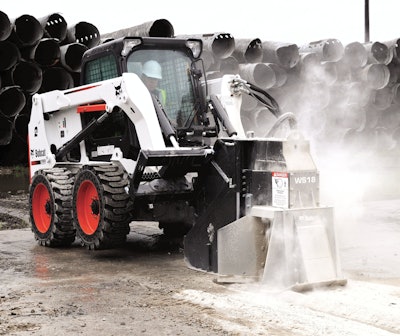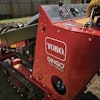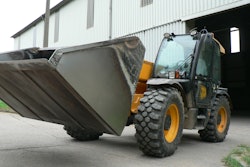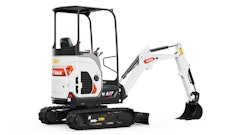
When skid-steer loaders started out they weren’t very complicated. They were four-wheel drive machines that allowed the operator to operate wheels on one side of the machine slower or faster than the other side as a means of turning it, causing the wheels to skid on one side of the machine. A bucket in the front mounted on arms that could be lifted allowed operators to dig dirt, haul material, and fine grade. But in more recent, years skid-steers have become a lot more complicated and useful for a wider range of activity. Cost is always important and contractors don’t want to buy technology that isn’t used but when they periodically trade in their machines for newer equipment there is also the need to include options that increase trade-in value. In order to help you with your decisions here is a rundown of what’s available today.
Operator comfort
Mike Fitzgerald, loader product specialist with the Bobcat Company, Fargo, North Dakota says there is a new emphasis related to operator experience. Cabs are much quieter and may have features like Blue Tooth for better sound and communication. The industry also recognizes that several operators might use a skid-steer during the course of a day, each having their preferences for steering and controlling the machine. So today most companies offer several steering and bucket control systems to accommodate operator preferences. Options include steering with levers, joysticks, “T-Bars” and foot pedals or electronic controls for operating attachments. You can also adjust what each control does. In the past operators learned how to control machines using a system specific to a brand—what they learned is what they want to continue using. But Brad Stemper, Solutions Marketing Manager for CASE in Racine, Wisconsin, says there is an increasing shift to electronic controls over mechanical or hydraulic ones as younger generations become operators. These electronic controls reduce operator fatigue after long hours of operation and provide a wider opportunity to customize control response and function.
With the shift to electronic control systems there is also the opportunity for both the office and the operator to know more about the performance of the machine and how productive it is. Fitzgerald says Bobcat is beginning to offer deluxe instrumentation panels that provide information about actual work time, engine fluids and maintenance needs, and gallons of fuel consumed per hour. Operators can also adjust how attachments are used, such as changing elevations for level grading operations without getting out of the cab. Electronic packages also make it possible for companies to set permissions for who is allowed to operate their machines, adding a measure of theft protection.
All skid-steer manufacturers offer enclosed cabs with HVAC packages for greater operator comfort. Also available are cab air protection systems—filtered pressurized air in cabs that prevents dust from getting in to create a safer work environment. Heated seats are even becoming an often selected option too.
Manufacturers are also designing cabs with greater fields of vision—including cameras, sensors and light packages that show what’s behind and around the machine increase safe operation.
Undercarriages
There are two types of undercarriages on the market; wheels and tracks. Brian Rabe, the Senior Product Manager for Skid Loaders and Track Loaders for Mustang, West Bend, Wisconsin, says track systems significantly add to the cost of a machine. But track loader sales continue to increase, currently being about 50 percent of the concrete contractor market. They offer much better traction in soft, wet soils but experience greater track wear on hard surfaces—a more bumpy ride for operators too.
Engines
The industry change-over to Tier 4 technology for diesel engines is complete. Stemper says the addition of fully electronic “common rail” technology—high pressure fuel (as much as 30,000 psi) waiting to be injected—increases engine efficiency and provides cleaner exhaust. With this technology engines can also develop more horsepower. Going hand-in-hand with common rail technologies are the emission control solutions. A primary goal for CASE is to impact the operator less with simpler-to-use systems with little-or-no change to maintenance needs on the machine.
Telematics and machine control
Gregg Zupancic, Product Marketing Manager for John Deere, Skid Steers & Compact Track Loaders, Moline, Illinois, says machine control technology allows instruments such as robotic total stations, laser levels, GPS, and sonic systems to control machine applications. At present skid-steer manufacturers either produce the control packages that are added to the hydraulics of the machine or they are working with third party companies to make and install them. Either way, machine control systems make it possible for skid-steers to quickly complete level fine grading for floor construction, excavate to a precise elevation, or even grade three-dimensional shapes automatically. During these operations, operators typically only steer the machine.
The cost of adding machine control technology can be high and operators need additional training so the added expense can cause contractors to hesitate. But on a jobsite productivity is greatly increased and initial costs are quickly recovered.
Telematics refers to the exchange of information about engine performance, maintenance condition, and run time.
Hydraulics
An increasing list of attachments such as cold planners and snow blowers require higher hydraulic flow (high-flow), an option has been available for some time. But high-pressure hydraulics are also beginning to be used to power some attachments. Zupancic adds that electro-hydraulics technology is being introduced. For example, operators can set a “creep mode” that allows a machine to travel very slowly but with full power. Bucket speed and rise can also be regulated for safer repetitive operations.
Attachments
When Louis and Cyril Keller built the first skid-steer in 1957—later to become the Bobcat Company—it had only one attachment, a bucket. Today there are perhaps hundreds of attachments available, making skid-steers the most widely adaptable machine in the construction, landscaping, and farming industries. Buckets are still the most popular attachment but there are many to choose from depending on the intended use. Increasingly attachments also require skid-steer add-on features such as high-flow or high-pressure hydraulics, machine control connectivity, and engine horse power, another reason to consider what you intend to use a machine for when you are deciding what to buy.
What you should include in your purchase
Contractors are naturally concerned about initial cost and not buying more than what they need for their intended work—extras can quickly add up. But there are some good reasons to include features beyond the basic machine.
When asked about features that should be included in a new machine purchase Zupancic suggests having a joystick (electronic) control system installed because future improvements will build on this technology. Cab improvements continue to be more important too. If you work in a freeze-thaw climate an enclosed cab with heat becomes important and the same is true for hot sections of the country where air-conditioning can reduce cab temperature. Dust control in the workplace and worker health is increasingly important so think about including a positive air flow option for cabs. Stemper says accident avoidance should be on your list of priorities too. Adding cameras, sensors, and work light packages—especially LED lights—extend an operators knowledge of the space around his machine.
Though you might not need a high-flow hydraulic system for the attachments you currently use, it’s a feature that can’t be added at a future time and might be worth the investment. Rabe suggests adding “powered attaching” technology too. It permits operators to quickly change attachments without getting out of the cab.
Kubota, Fort Worth, Texas, has been a trusted manufacturer of engines serving other equipment manufactures for many years. Two years ago they entered the skid-steer market with their own model. Jorge DeHoyos, their Senior Product Manager, says they decided to start with a more basic offering. Their basic machine includes a range of controls including hand and foot controls and hydraulic pilot joystick controls, an option to include cabs (which are included on half their sales) with pressurized and filtered air and HVAC, suspension seats for comfort, and good sound systems.
Future technology
The industry is already discussing Tier 5 engine technology and although no one is quite sure what this will include, increased fuel economy and less exhaust emissions will probably be the greatest emphasis.
Skid-steers in the future will offer more machine control and telematics options, further reducing the role and skill requirements of the operator. They will also be able to set more auto features for repeat operations.
Job costing in real time is a current goal for many contractors and this will drive the further development of skid-steer electronic packages that connect of the office to the jobsite, providing information about machine use and the progress of the construction.
Is now a good time to buy?
The answer is yes—you are no doubt surprised to hear this! But the construction industry is busy now; contractors have resisted buying new equipment during the downturn and are more willing to do that now. Tier 4 technology has become a stable engine platform and combined with common-rail injection offers greater fuel economy. Skid-steers have significantly improved over the past few years, and interest rates are currently good.
Skid-steer loaders are safer and more productive than ever before.





![[Video] Kobelco Reaffirms Commitment to North American Market with Grand Opening](https://img.forconstructionpros.com/files/base/acbm/fcp/image/2016/06/default.5755be5ce4865.png?auto=format%2Ccompress&fit=crop&h=167&q=70&w=250)

![[Video] Cat 910M, 914M, 918M Compact Wheel Loader Overview](https://img.forconstructionpros.com/files/base/acbm/fcp/image/2016/05/default.573f26547c866.png?auto=format%2Ccompress&fit=crop&h=167&q=70&w=250)













